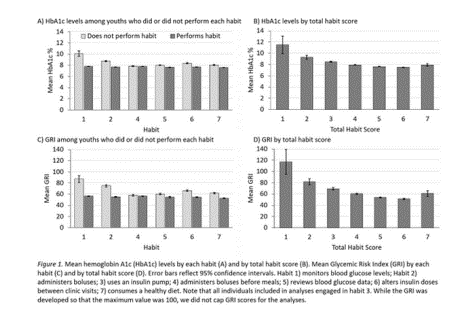Abstract: The Glycemia Risk Index Predicts Type 1 Diabetes Self-management Habits in Youth
K. Panfil1, C.A. Vandervelden1, B. Lockee1, E.M. Tallon1, D.D. Williams1, S.R. Patton2, C. Schweisberger1, J. Lee3, S. Corathers4, D.C. Klonoff5, M.A. Clements1
1Children’s Mercy, Kansas City, United States, 2Nemour’s Children’s Health, Jacksonville, United States, 3University of Michigan, Ann Arbor, United States, 4Cincinnati Children’s Hospital Medical Center, Cincinnati, United States, 5Mills-Peninsula Medical Center, San Mateo, United States
Introduction: The Glycemia Risk Index (GRI) is a validated measure of the quality of glycemic control in adults with type 1 diabetes (T1D).
Objectives: We sought to determine whether GRI associated with the 6-Habits score, a validated measure of youths’ engagement in diabetes self-management habits (Lee et al., 2021). We examined this association in the context of an additional (7th) habit designed to assess consumption of a healthy diet.
Methods: We retrospectively examined electronic health records of individuals who received care from a Midwest (USA) tertiary care pediatric diabetes clinic network. GRI was calculated based on continuous glucose monitor data, and habit scores were collected within 3 weeks of a GRI score. A mixed-effects Poisson regression examined how GRI associated with total habit scores, reflective of the number of T1D self-management habits completed. GRI, hemoglobin A1c (HbA1c), age, race, ethnicity, and insurance type were entered as fixed effects. Individual was included as a random effect to account for multiple observations.
Results: The cohort (N=1500) included youth with T1D ages 1.9-18.0 years, with 48.7% males, 86.7% non-Hispanic White, 70.0% on commercial insurance, and a mean age of 12.7 years (SD=3.7). GRI scores and HbA1c decreased as habit scores increased (Figure 1), suggesting individuals who performed more self-management habits achieved a higher quality of glycemic control. Age and insurance type were also significantly related to total habit scores. Older individuals had lower habit scores compared to their younger counterparts (t = -7.92, p < .001). Those with commercial insurance had higher habit scores than self-pay, public, or other types of insurance (t = 2.21, p = .03).

Conclusions: GRI associated with scores on the 6-Habits scale, providing validation for both measures. GRI may add value beyond HbA1c and sensor time in range as an indicator of the quality of glycemia in youth.
Link: https://www.react-profile.org/upload/KIT/system/uploads/ISPAD2023_Abstracts.pdf
